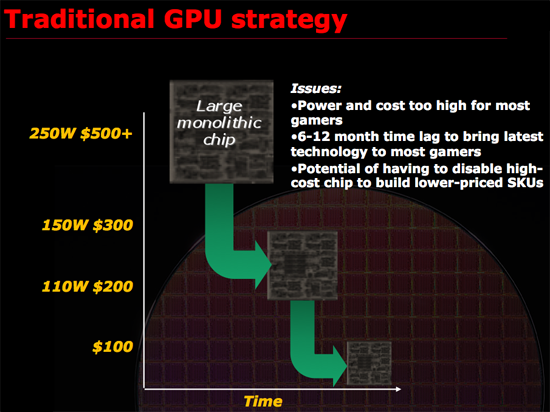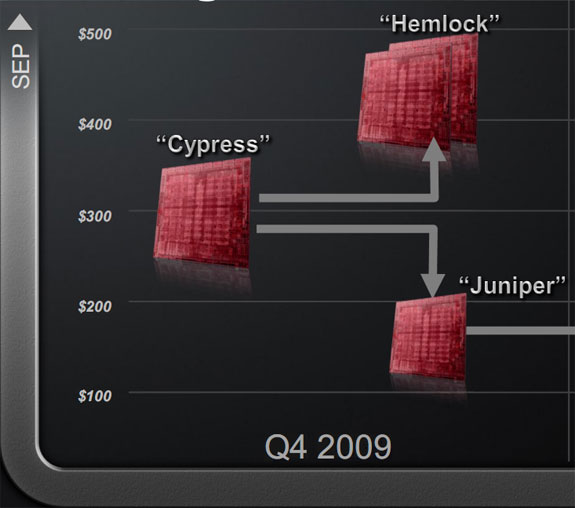The RV870 Story: AMD Showing up to the Fight
by Anand Lal Shimpi on February 14, 2010 12:00 AM EST- Posted in
- GPUs
What Made it All Ok: 4 GPUs in < 6 Months
Through a lot of hard work and sacrifice, even on Carrell’s part, ATI cut the RV870 from as much as 22mm on a side down to roughly 18mm x 18mm. The problem is that RV770 was around 16mm on a side. The RV870 was still too big.
Carrell wanted to cut it down even more, but two things changed his mind. First, in order to build 870 in the space of a 770 ATI would have to cut out much more from the chip than Carrell originally tought. One of the things that would have to go was some of the shader core.
In order to run the GDDR5 memory at the sort of data rates that ATI was targeting for the 5870 the analog PHYs on the chip had to grow considerably. At 16mm on a side ATI would either have to scale back memory bandwidth or eat into the shader core area. Either way we would’ve had a slower chip.
I asked Carrell if 16mm on a side would’ve made the RV870 $100 cheaper at launch, putting it on par with the RV770 launch prices. He said no. I didn’t find out why until much later, but I’ll save that story for another time.
Sacrificing performance to meet the 16mm x 16mm die size targets wasn’t going to happen, but what ultimately convinced Carrell to go with a larger die this time around was something that ATI didn’t get nearly enough praise for: the ability to launch 4 different 40nm DirectX 11 GPUs in less than 6 months.
Remember that Carrell’s beef with building the biggest GPU possible is that it takes too long for the majority of customers to get access to derivatives of that GPU. Look at how long it took G80 or GT200 to scale down. And who knows when we’ll see $150 Fermi/GF100 derivatives.

But ATI Engineering promised two things. First, that Cypress would have a successor called Juniper that would be ready around the same time. Secondly, two more GPUs would follow and the whole stack will be done and out in less than 6 months. ATI came close in 2008 with 3 GPUs in 3 months, but the fourth member of the 4000 series didn’t show up until April of 2009.
It wasn’t an impossible feat. ATI does have concurrent design teams and a lot of engineering resources in India/China. By working on Juniper in tandem with Cypress, assuming there were no show stopping bugs, ATI could exploit efficiencies in two teams effectively working on the same hardware (Juniper was just half a Cypress).
The idea of taking such a huge risk made Carrell uncomfortable. Running two GPU designs in parallel, for the same family of chips, is risky. If everything works out perfectly, you get two chips out at the same time. If it doesn’t, you’ve just tied up two design teams on one product generation. A slip here would give ATI its own Fermi.
What ultimately sold Carrell was the fact that engineering told him that they believed they could pull it off. Carrell believes in people. He believes if you expect the best out of those around you, then that’s what you’ll get. He couldn’t reconcile his beliefs with doubting the schedule engineering was feeding him. Carrell nervously signed off and the Evergreen stack was born.

Cypress and Juniper were delivered nearly at the same time. In fact, Juniper was ready a bit earlier and was sampled to developers months before ATI launched the 5000 series. Cedar and Redwood followed, not to mention a dual-Cypress board that became the Radeon HD 5970. And all of this was done and ready in less than 6 months (the chips themselves were all ready within 4 months).
When the smoke cleared ATI had new DirectX 11 parts at $600, $400, $300, $200, $150, $100 and $60. The Windows 7/DirectX 11 market bulge just got serviced.










132 Comments
View All Comments
wlee15 - Sunday, February 14, 2010 - link
The USS Hornet is a carrier not a battleship.For shame Anand For Shame!
Anand Lal Shimpi - Monday, February 15, 2010 - link
wow - you're totally right, I can't believe I made that mistake. Looks like Ryan or Jarred caught it shortly after it went live though, whew :)And yes, for the record, I know the difference between an aircraft carrier and a battleship :)
Take care,
Anand
just4U - Tuesday, February 16, 2010 - link
LIES!!!!(hah)
Sahrin - Sunday, February 14, 2010 - link
Thank you - I was worried I'd be the only one to point this one out.Thank you Anand! This stuff is incredible. Just a few weeks ago I was looking back on the RV770 article and wishing it could be done again.
Kudos as well are due to AMD's PR guys - for having the courage to let the engineers sit down with the press, instead of needing to be there as minders. I guarantee you that every single time, the same story told by a marketer of a product and by the guy whose passion created the product will be a thousand times more effectively conveyed by the engineer. Marketers have value - I'm not trying to write them off.
I don't know what I can do for AT and AMD to thank them for making articles like this happen. Aside from buying Cypress and being a reader - but if there is anything we can do to ensure these articles keep coming (bombard Meyer with Faxes?) let me be the first to sign up. (And maybe if we could get access to AMD's CPU guys as well, to provide a balance to the excellent information we get from Intel).
Dianoda - Sunday, February 14, 2010 - link
This article was a real treat, keep 'em coming...dzx - Monday, February 22, 2010 - link
I created an account just to give thanks for such a well written, informative article. I can sense you have just as much passion for the technology as the engineers and architects who create it. Simply a pleasure to read.gralex - Friday, February 26, 2010 - link
Thanx. I have nothing more to add that hasn't been said already in the above comments, just thanks.As for ATI vs. NVIDIA, maybe i'm believing the hype but AMD seems awfully conservative at the moment. It's totally working for them, of course, but I'm liking the whole CUDA, Tegra2, Ion, Optimus momentum Nvidia might finally be gaining right now. Obviously they messed it up with a ton of rebranding making a 5xxx purchase a no-brainer right now... I just LOVE the way Nvidia was looking cornered and thought up a number of ways to get out. I hope these two keep up the healthy rivalry for many years to come, for ALL of us:-)
phaxmohdem - Sunday, February 14, 2010 - link
Wow. This was perhaps the first article I've read in a long time I read cover-to-cover, and couldn't put down. AT is my favorite tech review site, but I find myself reading the first two pages or so, skipping around to various benchmark pages, then reading the summary. This piece was remarkably intriguing and thought provoking. I look forward to the RV970 story, or perhaps better yet, the GF100 story.Keep em coming!
gimmeausername - Sunday, February 14, 2010 - link
Did you just say RV970?I think you've just made some folks at AMD flip out by using that code name. :D
coolhardware - Sunday, February 14, 2010 - link
As others have mentioned, articles like this one really put Anandtech head and shoulders above the competition. It is so very interesting to find out the real world story behind the video cards. What a wonderful Valentine's Day treat :-).Thanks for all your hard work Anand, I really appreciate it!